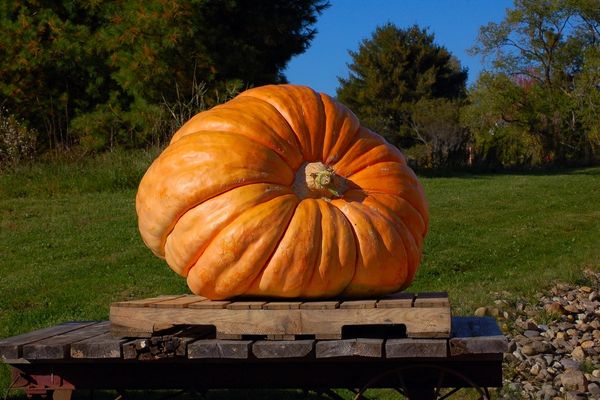
Pumpkin! The very word whispers of fall and Halloween and Thanksgiving and golden pies. The fruit of a vining squash plant, pumpkin plants sprawl out 6 feet in each direction, taking up a lot of landscape. The fruit itself can come in colors from white to blue and multicolored in addition to the well-known orange. They can be also lumpy and bumpy. One of the causes of the bumps is a mosaic virus. It’s often seed borne, and harmless to us. It just makes for a more interesting looking pumpkin!
We can grow pumpkins in Northeast Florida. The best conventional varieties for us in Duval County invite the question – do you want a show pumpkin or a pie pumpkin. UF has a few options here. Some growers have managed to get a fruit weighing in around 200 pounds!
Good News, Bad News
Florida has unique growing conditions – we have the heat that squash likes, but we have humidity and rainfall that encourages fungus too, so that’s not the best set of conditions. Caterpillars will attack pumpkins while they are soft skinned, although they can be controlled by a product containing bT, a biological control agent that only affects caterpillars.
Days to Harvest
All pumpkins take about 110 to 120 days to grow from seed to harvest. We usually start them in July, which times them to be ready for harvest about now!
Seminole Pumpkin
 Conventional orange pumpkins can be grown in Florida but won’t save very well in Florida. A better option is to grow the Seminole pumpkin. Grown by several Indian tribes for a few hundred years, this plant thrives through the Florida summer (unlike so many vegetable species!) While it was traditionally grown up the trunks of trees, most of us don’t want to climb the trees to harvest. It makes more sense to plant it on a trellis. Some people have opened tomato cages and reinforced them with rebar. Seminole pumpkins need no support while growing. Growing it up keeps the fruit off the damp ground.
Conventional orange pumpkins can be grown in Florida but won’t save very well in Florida. A better option is to grow the Seminole pumpkin. Grown by several Indian tribes for a few hundred years, this plant thrives through the Florida summer (unlike so many vegetable species!) While it was traditionally grown up the trunks of trees, most of us don’t want to climb the trees to harvest. It makes more sense to plant it on a trellis. Some people have opened tomato cages and reinforced them with rebar. Seminole pumpkins need no support while growing. Growing it up keeps the fruit off the damp ground.
More information about Seminole pumpkins is available at https://gardeningsolutions.ifas.ufl.edu/plants/edibles/vegetables/seminole-pumpkin.html
Once Harvested
Once you have a harvested pumpkin, it helps to wipe it down with a solution of 10% vinegar to kill off diseases present on the surface. If you are going to carve it, wait until the last minute. Up north, pumpkins last longer once carved because temperatures are cooler by this time of the year. Here, we bounce back into warmer temperatures during the day, more friendly to fungi and bacteria.
 Carved or whole, make sure you keep your pumpkin off the damp concrete and soil to help it last longer.
Carved or whole, make sure you keep your pumpkin off the damp concrete and soil to help it last longer.
And if you carve it and remove the seeds, roasted seeds are yummy and nutritious. If you don’t want to eat them, they are a treasured food for the birds. Just wash them, dry them on a paper towel and put them in your feeder.
***
This article was written by Master Gardener, Becky Wern.
 3
3

